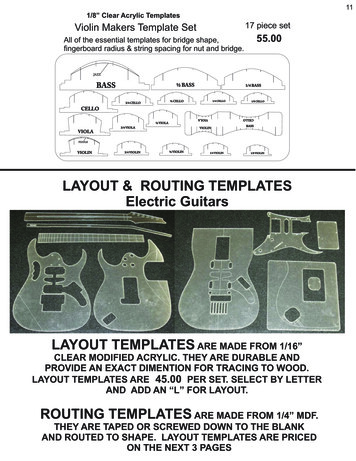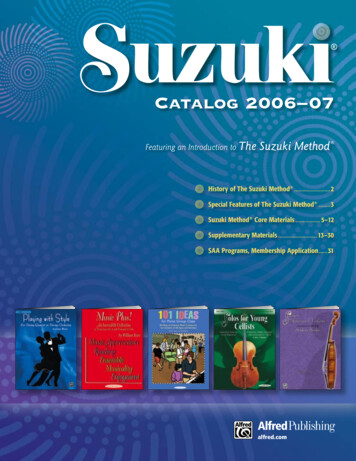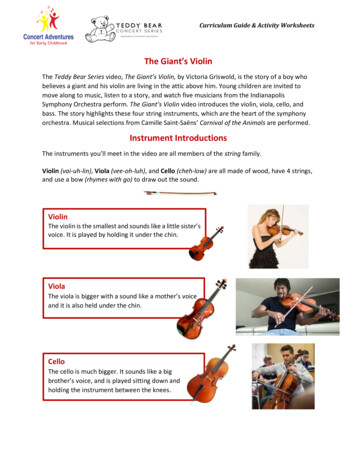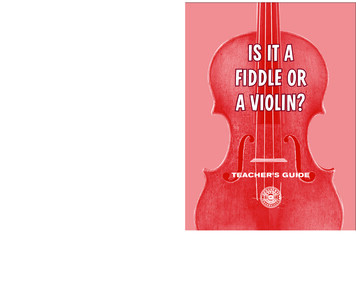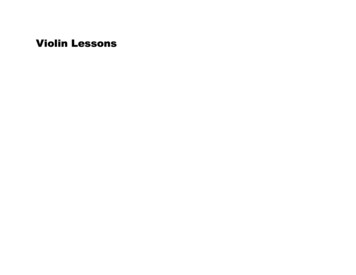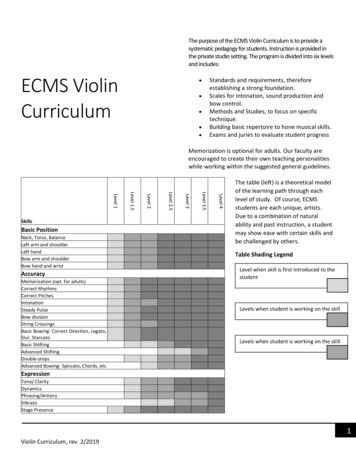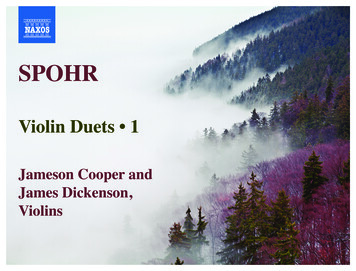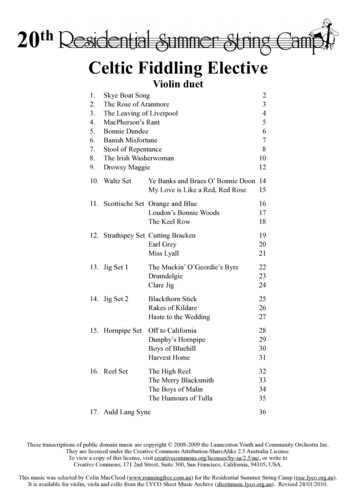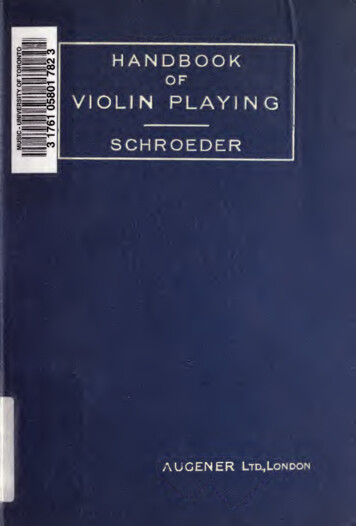
Transcription
AUGENER'S EDITION,No. 9212.HANDBOOKOFVIOLIN PLAYINGBYProf.CARL SCHROEDERTRANSLATED AND EDITED BYJ.MATTHEWSWITH AN APPENDIX CONSISTING OF AGUIDE THROUGH VIOLIN LITERATUREAND A CHAPTER ON THE VIOLAFOURTH EDITIONAUGENERLONDONLTD.
OCT3 20WPrinted in England.
CONTENTS.PARTI.The instrument.page13pageOrigin of the violinITheIoldest violins2The woodThe varnishThe strings3TheDevelopment and perfectingof the stinguishing features of theold Italian violins .Imitations of the old ItalianThe bow6Resin7Violin casesPrice of violins.Holding the22left hand and arm 23Holding the bow . 2 5Position of right hand and arm 25Examining the manner ofPosition ofholding2525BowingPrincipalsigns used for thehand andfor bowing 27Employment of up and downbows28The first exercises29leftbow.151616171818191919Preservation of the instrument 19Cleaning the hair of the bow 20Names of the strings, and.Price of violin casesPrice of bowstuningCompass of.,.,the violin-2021II.The technique of violinthe player . 22Placingviolin.1513PARTPosition ofstringsDifferent parts of theConstituent parts of the violin 10Function of the soundpostand bass bar12Position of the bridge . 12Amount of pressure on theupper table.guage410violins13Preservation of thetheSearch for the discovery of theold Italian makers' secretsstring.1414Strings pure in fifthsthepresent dayDimensions of the violinplaying.the fingersExercise in intervalsChords30in arpeggioStretching the 4 finger .Various styles of bowing and.their signs3741ArpeggiThe close shake (vibrato).The open shakeThe mordentThe double shakeScale playingFingering of scales333536.c.424244444546
CONTENTS.IVpageChromatic scalesThe4748positionsChanging the positionMovement of. 49the fingers inchanging positions . 49Diagram showing the positions 5QPARTDouble stopsChords in three partsChords in four partsHarmonicspage53. 586264Pizzicato69III.The performance.Artistic renderingTaste rial representation of the80bowingThe muteTheVibrator.Alphabetical list of celebratedviolinists of the 17*, i8th81and 19 th82Violinists of the. 842O th century 106centuriesTRANSLATOR'S APPENDIX.The Viola,Guide through Violin literatureGuide through Viola literature.106109179
PARTI.The instrument.Origin of the violin.The invention of stringed instruments is certainly ofgreat antiquity, but exact information with regard to theorigin of the violin has not come down to us.Althoughstringed instruments were in use before Christian times,we know that these had nothing in common with theviolin, or that at any rate the bow was not then known.It is therefore presumed that its invention and use inconnection with stringed instruments occurred in the firstcentury of the Christian era.Many are, notwithstanding, of the opinion that theuse of the bow was known in pre-Christian times,in Indiaand in Persia. Pictures of Indian and Persian bowedinstruments exist, but the period when they were employedis not exactly known.See Fig. a and b of page 2.Theoldest violinsknownare those of the Tyrolese Lute maker GaspardthDuiffopruggar (Tieffenbrucker) , made in the i6century.A few of these instruments remain to the present day,and are noticeable on account of their fine, clear tone,as well as for the neatness and elegance of their work-manship.Schroeder, Catechismof Violin playing
FIRST PART.Developmentwhoof the violin.After Duiffopmggar the following makers were thosechiefly laboured to perfect the violin:GaspardSalo (middle of the iy thcentury), Giovanni PaolodaMaggini (15901640), Andreas Amati (15201580), hissons Antonius and Hieronymus Amati, the son of thelatter, Nicolas Amati (15961684), the pupilsof theRababa.Arabianbowed instrument (ofPersian origin).b.RabaIndianviolin.same:Jacob Stainer (1621Of1683) and Antonius Stradi-the Amati violins, those ofNicolas Amati are the best; the most perfect specimensof violin-making, at present unsurpassed, were made byIn his instruments everything is perfected,Stradivarius.tone, model, varnish, etc.After Stradivarius the finest violins are those of hispupil Joseph Guarnerius del Gesu (16831745), and thereare many of them which rank with those of Stradivarius.varius(16441737).
THE INSTRUMENT.3Tothe Guarnerius family of violin makers belong AndreasthGuarnerius, pupil of Amati (middle of the 17century),GuarneriusGuarneriusPeterhis son Joseph(16801730),and the son of the elder (Andreas) Guarnerius (1725 1740).The names Stradivarius and Joseph Guarnerius mark thehighest achievement of violin making, and to the presentday none have succeeded in surpassing them. Of otherItalian violin makers who have furnished us with goodinstruments may be mentioned Alessandro Gagliano(16951725), Carlo Bergonzi (1712 1750), Laurentiusth andthGuadagnini (close of the 17beginning of the i81785), Dominicuscentury), Joh. Bapt. Guadagnini (1755Montagnana (17151750), Vincent Ruggeri, Giov. Bapt.thRuggeri, and Peter Jacob Ruggeri (beginning of the i8InviolinsweremadeFrance,goodby Lupotcentury).thth(i8 century), Gand, Bernardel (i9 century) and Vuillaume(17981875). In Germany, besides Stainer and his pupilAlbani of Botzen, Klotz, (father and son) 17 th and i8 ththcentury in Mittenwalde; Witthalm (i8 century, Nuremburg);Bausch (father and son, Leipsic, 1805 1871 and 18291871), Jacob Diehl (Hamburg). In England, B. Banks, Salisbury (1727 1795):, R. Duke, London (17541780); JacobFendt and C. Harris (early part of the present century), andMatthew Hardie (Edinburgh), have left many good violins.Prominent makers of the present day.Goodviolins aremadein the presentday by HammigSchunemann, Schwerin; Pfab,Hamburg; Lenk, Frankfort; Reuner, Berlin; Roth, Markin Leipsic; Reichers, Berlin;neukirchen,etc.excellent instruments have been andare being made by Hill, Hart, Chanot, E. Withers, andBoullangier, London; W. H. May son, Manchester; F.Devoney, Blackpool; J. Monk, Merton, Surrey; andIn France, by Miquel, Foucher, Lotte; and inothers.[InAmerica,EnglandGemunder.These haveallproducedservice-able instruments. Ability to judge properly the meritscomes only withwhether new or old,of a violin,experience; beginners should therefore before purchasingconsult a player or teacher possessing the necessaryknowledge. Violins by the same maker, to all appearanceexactly alike, yet frequently differ greatly in tone quality,
FIRST PART.4and an instrument of bad tone is a stumbling block inthe path of progress, disheartening the learner.Tr.]improving theatAttemptsviolin.have been made at improving theform and proportions, and by usingother kinds of wood:metal, glass, and porcelain violinshave also been constructed.Experiments have beenManyattemptsviolinbymadewith the bass bar, bridge, sound-post,alteringitsmake aetc., in en-advance in violin making; butall these attempts have yielded no results of importance.The most remarkable attempted alteration of latter daysproceeds from the piano maker Hagspiel in Dresden, andconsists in bending or arching the upper table of theviolin instead of working it out, the sound-holes appearingas round openings in the ribs instead of in the upperdeavours tofurthersurface.The tone of these violins is of surprising powerand volume, but they demand a peculiar, and somewhatfirm bowing; a heavier bow is also needed.The makerproceeds on the assumption that there exists, in modernorchestras a tonal gap between the string and the brassThe toneinstrument.of the stringed instrumentsisoftenby the predominating force of the windquite overpoweredinstruments. Thisespecially noticeable in opera orchewill seldom permit of more than10 or 12 first violins, and the same number of secondviolins; for instance in the instrumentation of Wagner'sNibelungen Ring. In its production the wind instrumentsneed so much space in the orchestra, that instead of acorresponding increase in the number of the strings, theymust often be lessened, naturally occasioning a want ofstras,wherebalance.Atheirisspaceselection of the instrumentsmade by Herrviolins, violas, violoncelli and double basses,probably tend to lessen this disproportion, as oneHagspiel,wouldof them yieldsat least asmuchtone as two of the ordi-nary instruments. By sufficient familiarity with the methodof using them, the tone might be made to blend uniformly with that of the other instruments in passages ofa light and soft character. In any case the inventor hasthrown out a suggestion, and made a beginning towardspreparing the way for a correct balance of tone in theorchestra,andhisidea therefore deserves consideration.
THE INSTRUMENT.CThe author is not aware if practical experiment in theorchestra has been made with these instruments, but itshould certainly give some advantageous result.Another invention has been produced recently byHerr Christopher Scheinert in Berlin. It consists of ahammeror tongue for stringed instruments.instrument placed under the bridge ofthe violin, so that, (it being furnished with a slenderhammer), elastic metal tongues vibrate freely between theupper table and the strings. The vibrating hammer isset in motion through the strings by the bow, throughwhich simultaneous movement the power of the instrumentis increased, and the tone colour elicited.Experts havetested the contrivance, declaring it to be a happy idea.Professor H. Ritter's invention of the normal threefooted bridge must also be mentioned. Assuming thatthe bridge in use for centuries, with its prescribed feet,does not fully convey the vibrations of the strings to thevibratingThisisalittlethe two middle strings sounding feeblertable,than the outer,Prof. Ritter has made a middle pointof contact between the bridge and the upper table. Thisinner support is intended to make the middle strings soundupperwith thesameintensity as the outer ones.In his pamphlet on the subject (Wurzburg, G. Herz),Herr Ritter demonstrates that his three-footed bridge has
FIRST PART.6not only an aesthetic significance, but claims consideration*scientifically.Attempts to discover the secrets of measurementof the Italian violin makers.For a long period violin making was restricted (deviations such as the experiments explained above, notwithstanding) to imitating the first Italian masters of the art,and endeavouring to equal them. But so conscientiousand true in all their parts and contents is the workmanship of the Italian instruments that this has not beenattained.very general opinion is, that certain secretsin instrument making were known to the Italian mastersbut have become lost, and many have made the attemptmaker in Aix la Chapelle,to re-discover these secrets.named Niederheitmann, a violin amateur, possessing acollection rich in valuable old violins, believed the mysteryto be discovered, and that it consisted in impregnatingAAthe wood. The substance used was a species of pinefound in the vicinity of Cremona, or the instrument wasmainly built of this wood. This pine (balsam pine) became quite decayed by the drying up of its resin, andthereby the key to the enigma why in spite of the closestimitation the old Italian tone was not arrived at, wasfound. This pine exists no longer in Italy, and thus wasto be explained the reason why notwithstanding theclosest copying of existing instruments, the old Italianfriend of Niederheittone quality was not reproduced.mann's, Concertmeister Henry Schradieck (formerly ofLeipsic) interested himself greatly in this discovery, andhaving obtained through a chemist a similar resinousA* With the same intention Mr. E. J. Bonn, of Brading, Isleof Wight, has produced a four-footed bridge, which, upon thetestimony of those who have tried it, has in some cases effectedan improvement. Testimonials from great artists concerning these,and other attempts at improving the violin frequently appear;meanwhile, the artists themselves are well content with the bridgeand the instrument generally as left by Stradivarius. One wouldnot desire to deny the possibility of further improvements to theinstrument, yet nearly two centuries of ceaseless experimenting haveof universalyielded no result that has been considered worthyadoption.Tr.
THE INSTRUMENT.7substance, made, with the aid of Herr Hammig in Leipsictrials with this impregnation, from which a remarkable result was to be got, but which was not of longmanyHerr Schradieck, who went later to America,balsam pine still grew there, did notrest until he found this tree, believing that instrumentsmade from it would again approach the old Italians.Several violins were found already made with balsam pinewood, but the brilliant expectations that were cherishedwere not fulfilled.duration.knowingthat thePoints of note in the old Italian violins.Theseinstruments are of largehighly arched and the archingThe wood ofrises somewhat suddenly from the edges.The back,the upper table is thick and very good.compared to the upper table is less thick. The wood ofthe back is taken slab-wise (the trunk of the tree beingcut in layers across the whole breadth).*The sides areshallow.The varnish is thin, transparent, and of a clearMagginibrownviolins.The upperoutline.tableisThepurfling is frequently doubled; andin arabesques.The tone of theMaggini violins is full and heavy, resembling the violaThe ticket is as follows:quality.colour.backspread over theGio. Paolo Ma ini, Bresci*.Andreas AmatLThese are mostly of small model.of good, fairly thick wood, and veryhighly arched towards the middle. The back is cut onThe uppertableTheisis brown andThetransparent.and not powerful.Antonius and Hieronymus Amati. The violins issuedas the work of the two brothers in partnership are muchthe slab.toneisvarnishdelicateesteemed. More instruments of small than of large sizewere, however, produced by them. The upper table ishighly curved, and has towards the edges a groove or*Regarding these two figures as sectionsof a trunk of maple the first shows how theslab back is obtained,(sur couche) and thesecond the other method. Tr.
FIRST PART.8furrow.wise.violins.The wood of the back and of the ribs cut slabThe varnish resembles that of Andreas Amati'sThe tone is also small. The label runs:Antonius&Hieronhmis AmatiCremonen. Andrafilii16Nicolas Amati. These instruments are distinguishedfrom those of the other Amati violins by a grander appearance, better and thicker varnish, and a more brilliantand penetrating tone. The scroll is somewhat small inproportion to the body.Label:Nicolaus Amati Cremoncn. HieronimLfiliiAntoriiincposfecitAnno 16In the career of Stradivarius threeStradivarius.periods may be traced, and the violins proceeding fromeach of these distinct periods themselves vary more orThe instruments of the first period differ but littleless.from Amati violins, and are classified as being of theschool of Nicolas Amati. The instruments of the secondperiod are already quite different from the first. Thewhole model is larger, the arching finer, the wood of theupper table and also of the back is stronger, and thevarnish redder in colour. From the third period proceededThe model isthe finest violins that are in existence.again somewhat larger, the upper table is flatter, the woodof the back and of the ribs instead of being cut on thelayers in slab form (sur couche), is taken on the quarterThe varnish is still more brilliant, yet soft(sur maille).looking, and so transparent that the beauty of the woodunderneath it is fully brought out. The f holes arewonderfully cut, and the entire work is finely finished inevery detail. The tone fulfils every possible requirement,it is of great power and body, sparkling, noble, and yetThe violins made in the lastsympathetic and sweet.
THE INSTRUMENT.the weakness pertaining toyears of Stradivarius revealold age. The tone is still fine, but the workmanship isFrom this time forward, when thealtogether inferior.varnish darker, thearching is more prominent, and theLabel:isdiminished.tonetheofbeautyAntonius Straduarius CremonensisTadebat A? 17.Labels of various other Italian makers:Francescus Ruggeri dettoin Cremona dell' Anno 16ilperHieronymus Amalus Cremonen.Nicoiai Figlius FecitI]Joannes Baptista Guada nini Piecentiaus fecit Mediolani I/lofephns Matlli AlbannfecitBiilgani in I' or ole Anno 17lanuarius Ca lianus AHimnns Aiitoniifecit Ncapoli Amu) i
FIRST PART.10Joseph Guarnerius, Andrsenepos.Cremouse 17IHSImitations of old Italian violins.The old Italian violins have been so closely copiedby many makers, with regard to model, wood, varnishand appearance of age, that it is difficult to discriminatebetween the genuine and the spurious. It is still moredifficult when the copy possesses a fine quality of tone.It needs a practised, keen eye to determine the genuineness or spuriousness of an instrument, and it may wellbe that many, believing themselves to have bought a realold Italian instrument, have only obtained an imitationThe inside ticket has of itself been closelythereof.copied, and may be purchased in sheets.Constituent parts of the violin.The most importantpartisthe upper table or bellyExterior.(a).
IITHE INSTRUMENT.Thethe back (c),other parts are the ribs or sides (b),the scroll and pegheadthecomprising(d),the pegs (f) the finger board (g), the bridge (n),theneckbox(e),Interior.the tailpiece (i), the button* (k), the nut (1), and the for sound holes (m). The interior of the violin containsthe soundpost and the bass-bar.*Thesemi-circular projectiontermed the button.Tr.at thetop of the backisalso
FIRST PART.12Function of the Soundpost and the bass-bar.The soundpost, placed underneath the right foot ofthe bridge (a little way behind it) supports the uppertable against the pressure of the strings upon the bridge,and the bass-bar serves a similar purpose under the leftThe sound post, by connectingfoot of the bridge.the upper table with the back, sets the entire instrumentinto vibration, and by its help the sound waves radiate toall parts.Position of the Bridge.The bridge must stand on the middle of the uppertable so that both feet are in line with the nicks of theinf holes.Through the forward pull of the strings,the bridge has a tendency tocreased during playing,bend forward. To avoid this one must frequently watch,and pull it backward, yet keeping the feet in the sameThe bridge may be fixed sloping somewhat backplace.ward rather than forward.*soft,affect* Thewhether hard orquality of the wood in a bridge,and its thickness (according to Otto, its weight), materiallythe tone of a violin.Bridges as supplied by dealers areusuallyalmost twicetheproperthickness,toallow for rubbingdown with sandpaper.The best bridges arethe genuine "Aubert"(with the name stam-ped inside anoval);those with large auddecided reddish markhardings showingness of grain and the,less distinctmarkingsa softer quality. Whenfitting a violin, a fewof each should be tried,cutting the feet tothe approximate slopefirstwith a sharp penknife,then with a small piece of fine (No. o.) glass paper held steadilybetween the ff holes, rub the bridge to and fro over the glasspaper between the notches of the ff holes, until, on removing theglass paper it is seen to fit perfectly, standing upright when the
THE INSTRUMENT.Amountof pressurej*upon the uppertable.Through the combined influence of the strain andpressure of the strings upon the upper table, it supportsa weight of about 100 Ibs. Against this burden, this, infragile instrument, opposes a wonderfulresistance, an example of its ingenious yet simpleother respects,power ofconstruction.Size of the violin.Theviolinmeasures in the length of its body 14 in.,39upper part 6 / 10 in., in the lower S / in.in breadth in the8top height of sides i / 16 in.; bottom height of sidesaresizesThree"full", "threedistinguished,/ These last serve for children.quarter", and "half" size.Thei1in.The woodof the violin.madeof pine. This must beThe uppervery old, dry, compact, straight in grain, whereby theFor thechoice of suitable wood is rendered difficult.tableisback, ribs, neck and bridge, maple is used. The soundpost and bass-bar consist usually of pine. For the fingerboard and pegs*, ebony is the most serviceable.The old Italian violin makers procured their pinewood from Italian Switzerland, and from the South Tyrol;maple from Croatia, Dalmatia, and Turkey.The sketch shows the amount of slope to beinstrument is level.made on the E side; the distances for the notches to receive thethe feet must be thinned in anstrings, and the amount to whichThe height of the bridge is depenordinary full sized instrument.dent, (for convenience of stopping), upon the height of the fingerboard.high bridge gives more power, but often the quality oftone is not so good. The E string being harder to press down (byreason of its greater tension) is kept a little nearer the fingerboardthan the others. From the end of the fingerboard, the E stringAshould be about this distancetheGOn */ 2 size and 8/ 4 size instruments for children thesemust be reduced about one-third. Tr.distances* Boxwood and rosewood are also frequently used for theThe former gives a firm hold, but makes a creaking noisewhen tuning. Rosewood answers its purpose well, though it is notpegs.so strong as ebony, which howeverismore aptto slip.Tr.
FIRST PART.Thevarnish.Thisis of great importance for the instrument.Inplace it preserves it from the influence of theweather, and then it also has its influence upon the tone.fine varnish must be transparent, so that the woodthefirstAunderneath may be fully shown up, and it must also beof a fine, but not glaring or staring, colour. The finestvarnish is found on the violins of Stradivarius. Two kindsa gum dissolvedof varnish are used,spirit varnish,a gum dissolved in oil ofin alcohol; and oil varnish,turpentine.Thestrings.Violin strings are made from the intestines of sheep.lowest string has fine wire spun round it, silver wirebeing the best Copper wire is greatly used, it beingmuch cheaper. The best strings are obtained from Italy,Thefrom Rome, Padua, and Naples, although very goodstrings are also manufactured in Germany, at Markneu-The value of a string consists principally in itsperfect equality of thickness throughout; above all, theremust not be knots in itstring spun quite evenlyyields accurate vibrations, and is on this account purein tone.In order to test the purity of tone of each string, itmay be held as shown at both ends, pulling it rathertight, and then setting it into vibration with one of thekirchen.Afingers.itIfitappears double, thus:possesses a pure tone; if, however, it appears threeif only at oneit will be false.part of it,fold,
THE INSTRUMENT.Strings pure infifths.obtain absolutely pure intonation, the strings mustin fifths, i, e., the notes in those higher positionswhich are pressed by one finger acrossTobe puretwostrings,must sound perfectlytrue.strings are rather thicker at onethan at the other; if this is not alsoManyendthe case with the adjacent string, or if thethicker end of it be not stretched inthe same direction as the other string,then the two are not true in fifths witheach other. Both strings must thereforebe from one end to the other regularin thickness, or else their thin ends mustbe laid in one direction.* In the lattercase, however, all the harmonic notesare not true, and one also notices thatthe intervals in double stopping generally,as well as in fifths, are not regular upontreatment is in vogueall the strings.by makers of strings and instruments bymeans of which the strings are renderedAfifths. These prepared stringshowever, not so durable, nor so goodin tone, as the unprepared. But it is ofservice to have always a few of these in readiness, as the violinist has not always timeenough to select those strings whichquite pure inare,are true.stringsWeichhold, Dresden, suppliespure in fifths, which may be re-commended.The string guage.In order always to have strings ofthe same thickness, a string guage isused, which may be procured at anyinstrument maker.**String guage.* It is best tocompare the ends before putting the stringThe lasttying the knot at the end which appears thinnest.inch or so at each end of even the best string is often rough, andnot so durable as the rest of it.7 .** To ensureequality of tone it is very important that thestrings should be correctly guaged with regard to their relativeon,
FIRST PART.i6Care of thestrings.That the strings may be kept fresh, it is advisable towrap them in oil paper and then preserve them in aIn this way they may be preservclose, air-tight tin box.ed in fit condition for a year or more.This receivedhas undergonewas arrivedthicknesses.itsmanyThe bow.name from itsalterationsancient form, whichbefore the present format.If allthe strings are too thick,theinstrument willspeak with difficulty in delicate passages, demanding a heavierpressure of the bow; if too thin, loss of power will be the result,though with a corresponding gain in sweetness and clearness, andif one string be much out of proportion to the others, the firstfinger when placed properly on that string and the adjacent onewill not yield a perfect fifth, besides the inequality in power.Thefollowing diagram shows a set of strings of medium thickness,together with the distances apartDnear the bridge on a full sizedviolin, as suitable for ordinaryhands.For fingers that tapermuch towardsthe tips, or forthose that are very broad, thedistances may be made a littlenarrower or wider accordingly.First strings of silk, known as"Acribelles" are in great deplayers with perspiringhands, as they are less affectedby moisture than gut, but themand byBRIDGE.toneisnotsogood.Theybutpossess certain advantages in durability, and standing well in tune,are more difficult to tune, as a very slight movement of the peg willsend them up half a tone. When frayed, they should be removed, theotherquality of tone they then yield being very bad, affecting theIf gut strings of good quality are bought, and the stringsmomentscarefully looked at before playing, breakages at awkwardstrings.willseldom occur, as the strands generally give warning before breakingby showing symptoms of unravelling, especially at the knot end,when they should at once be replaced. Tr.under the bow,or
THE INSTRUMENT.The greatest improvement in the bow was attainedby the Frenchman, Tourte, at the end of the i8th cenHis bows possess the greatest elasticity and firmtury.ness, and are, in consequence, the most successful. AfterTourte, Vuillaume in Paris, John Dodd in England, andL. Bausch in Leipsic, have made the best bows.Atpresent the most celebrated bow makers* are Tubbs inLondon, Knopf in Dresden, and Voirin in Paris. Frenchbows are most in request, although many of them aremade in Germany, sent en gros to Paris, stamped thereas French, and issued to the world as of Parisian make.Constituent parts of the bow.These are(a)the stick, (b) the hair, (c) the nut,head or point, (f) the lapping.(d) the screw, (e) the . SS*SS'\e.IJLj J 1 '-Fm*r*gf*I*\cT Thethe hairmade of Pernambuco or Brazil wood;white horse hair, that taken from living horsesstick isisSchroeder,Catechism of Violin playing.2
FIRST PART.jgless often obtained.The screwto give the stick its proper curve.The lappinghelps to give the fingers a firmer hold, avoiding contactwith the smooth stick. Silk, silver wire, or leather is usedfor the lapping.*being the best, thoughservesResin.Toset thestrings in vibration,the hair of thebowmust be rubbed with resin. Its German name "Kolophonium" is derived from the Grecian town Kolophon, fromwhence it was first procured. The unprepared hair of anew bow requires a small quantity of powdered resinrubbed into it. Before the bow is used, the hair shouldbe tried upon some instrument not in use, or upon astretched string. During the ordinary rubbing upon the hair,care must be taken that the resin is not rubbed hard, butallowed to glide lightly over the hair.It is very usual to hold the resin with the left andthe bow with the right hand. In this way the fingers ofhand becomesticky with resindetrimental to the stopping,and also soils the strings and fingerboard.It is better, therefore, to reverse thistheleftdust,whichisGood resin is supplied byGand and Bernadel in Paris, HammigPfab and Diel in Hamburg, and others. Theprocedure.in Leipsic,most ouicable holders are thoseand arewhich open on twosides,also provided with a cover.**Violin cases.Agood violin is worthy of a good case, to protectIt should be so filled that theagainst dust and damp.violin lies in it securely, and yet may be easily taken out.leather covering for the case is also convenient, byitA* Kid ot reasonable substancegives a pleasant hold for thealthough wire is in greater favour with bow makers forfingers,appearance sake. But it is apt to tarnish and unravel, especiallyTr.where the thumb comes in contact with it.** A convenient form is thatprovided by many English dealers,with apreferably of tin,consisting simply of a round box,hole in the bottom for the finger to push the resin up, preserving7 .the upper surface level.
THE INSTRUMENT.means of which theeffectsof anyTsudden shockgareThe best cases are mostly obtained fromthough some very good ones are made in Mark-minimised.Paris,neukirchen.Prices of violins.It is not easy to state the exact price of a violin,especially of an old one, and here particular fancy andhabit come also into the question.The best old Italianviolins, such as those by Stradivarius and Guarnerius, arein our own time excessively dear, often 300 to 1000,and even more. Stradivarius received for his violins about4 Louis d'or. Amati violins are considerably less, costingfrom 150 to 5 300.Other old Italian violins, if infine condition, cost 30 and upwards.New violins bycelebrated makers may cost from 15 to 30, yet onecan often get a very useful instrument for from 5o/-upwards.Prices of Violin cases.Cases cost froma leather covering.5/- to 5 3,the latter priceincludin
CONTENTS. PART I. Theinstrument. page Originoftheviolin I Theoldestviolins I Developmentandperfecting oftheviolin 2 Prominentmakersofthe presentday 3 Attemptsatimprovingthe violin 4 Searchforthediscoveryofthe oldItalianmakers'secrets6 Distinguishingfeaturesofthe oldI
